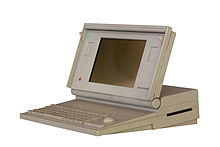Macintosh Portable
This article needs additional citations for verification. (September 2018) |
 | |
| Manufacturer | Apple Computer, Inc. |
|---|---|
| Type | Portable computer |
| Release date | September 20, 1989 |
| Introductory price | (with hard drive) US$7,300 (equivalent to $17,943 in 2023) |
| Discontinued | October 1991 |
| Operating system | System 6.0.4 |
| CPU | 16 MHz 68000 CPU |
| Memory | 1 MB SRAM (expandable to 9 MB), 256 KB ROM |
| Storage | 1.4 MB double-sided floppy drive, 40 MB 3.5″ Conner hard drive |
| Display | 9.8″ black and white active matrix LCD screen |
| Graphics | 640 x 400 pixel, 1-bit |
| Input | keyboard, trackball |
| Power | 5W, 13 amps, lead-acid batteries, AC Charger |
| Dimensions | 4.05″ x 15.25″ x 14.43″ |
| Mass | 16 pounds (7.2 kilograms) |
| Predecessor | Macintosh Plus (Macintosh SE) |
| Successor | PowerBook 100 PowerBook 140/170 |
Macintosh Portable is a portable computer designed, manufactured, and sold by Apple Computer, Inc. from September 1989 to October 1991. It is the first battery-powered Macintosh, which garnered significant excitement from critics, but sales to customers were quite low. It featured a fast, sharp, and expensive black-and-white active matrix LCD screen in a hinged design that covered the keyboard when the machine was not in use. The Portable was one of the early consumer laptops to employ an active matrix panel—only the most expensive of the initial PowerBook line, the PowerBook 170, had such a panel—mainly due to the high cost. The machine was designed to deliver high performance, at the cost of increased price and weight. The Portable was discontinued in October 1991.
Hardware
The pointer was a built-in trackball that could be removed and located on either side of the keyboard.
Display
Despite the dramatic improvement in terms of ergonomics offered by the responsiveness, sharpness, and uniformity of its active matrix panel, one of the primary drawbacks of the Portable was poor readability in low-light situations.
Consequently, in February 1991, Apple introduced a backlit Macintosh Portable (model M5126). The backlight feature was a welcomed improvement, but it reduced the battery life by about a half. An upgrade kit was also offered for the earlier model as well, which plugged into the ROM expansion slot.
Memory
The Portable used expensive SRAM memory in an effort to maximize battery life and to provide an "instant on" low-power sleep mode.
In the newer backlit Portable, Apple changed SRAM memory to the less expensive (but more power-hungry) pseudo-SRAM, which reduced the total RAM expansion to 8 MB, and lowered the price.
Drive configurations
There were three drive configurations available for Macintosh Portable. A Portable could ship with one floppy drive, with two floppy drives, or with a hard drive and a floppy drive. The floppy drive is 1.44 MB.
Most Macintosh Portable units came with a hard drive. It was a custom-engineered Conner CP-3045 (known by Apple as "Hard Disk 40SC"). It holds 40 MB of data, consumes less power compared to most hard drives of its time, and it has a proprietary SCSI connector; adapters that allow standard SCSI drives to be used on the Portable exist, but they are expensive.
In addition, at 16 pounds (7.2 kilograms) and 4 inches (10 centimetres) thick, the Portable was a heavy and bulky portable computer. The main contributor to the Portable's weight and bulk was its lead-acid battery.[1]
Battery and known issues
The lead-acid battery on the non-backlit Portable offered up to ten hours of usage time, and the Portable draws the same amount of power when turned off, and when in sleep mode.[2]
Unlike later portable computers from Apple and other manufacturers, the battery is wired in-series with the AC power supply. There being no possible alternative direct connection to the AC supply, a flat battery meant that the computer could not be operated. The original power supply had very low output. Several popular unauthorized workarounds were devised, including using a power supply from the PowerBook 100 series, which provides higher output. As with automotive batteries, the sealed lead-acid cells used in the Portable failed if they were fully discharged. The batteries are no longer manufactured and it is very rare to find an original battery that will hold a charge and allow the computer to start. It is possible to repack the battery with new cells, or use alternative 6 V batteries.[3] There were three lead-acid cells inside the battery: each were manufactured by Gates Energy Products (now EnerSys), and they were also used in Quantum 1 battery packs for photographic flash use.
Operating system
Macintosh Portable can run Macintosh System 6.0.4 through System 7.5.5.
Legacy
In May 2006, PC World rated Macintosh Portable as the seventeenth-worst tech product of all time.[1] By contrast, MacUser magazine noted, that this machine tended to remain relevant, and therefore tended to have a long usage lifespan for those who bought it, reducing its total cost of ownership.
See also
- Outbound laptop, a Mac-compatible laptop available during the same time period as the Portable. It was significantly smaller, less expensive, and lighter, but offered a much less responsive "twist" STN LCD and a less ergonomic pointing device. It was also restricted to 4 MB of RAM, due to the requirement that users install a ROM chip from an Apple machine such as Macintosh Plus.
References
- ^ a b PC World (May 26, 2005). "The 25 Worst Tech Products of All Time". Retrieved July 18, 2006.
- ^ "Mac Portable". Low End Mac. February 16, 2018. Retrieved November 24, 2020.
- ^ "Alternate Battery for Mac Portable". Low End Mac. Retrieved January 8, 2013.
External links
- Mac Portable profile on Low End Mac
- More pictures of a Mac Portable
- "Macintosh Portable, 360-degree model", Russian Vintage Laptop Museum (museum)
